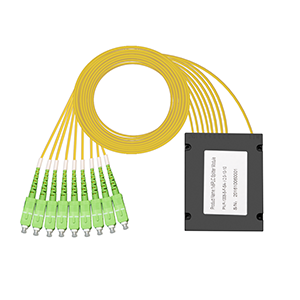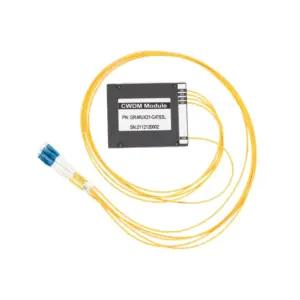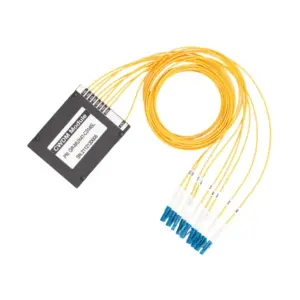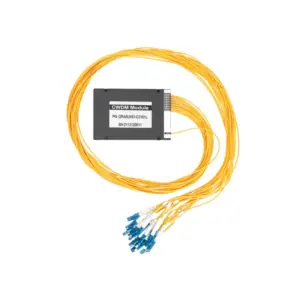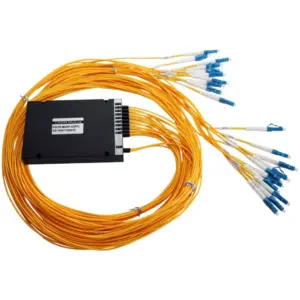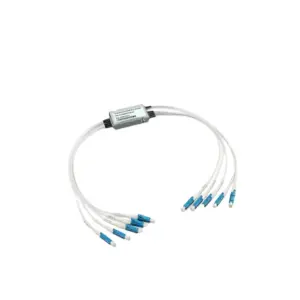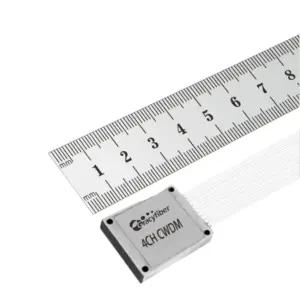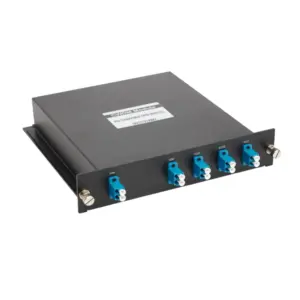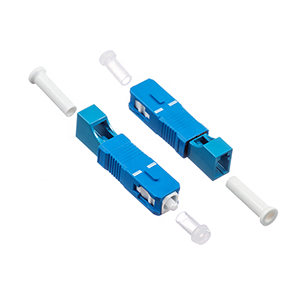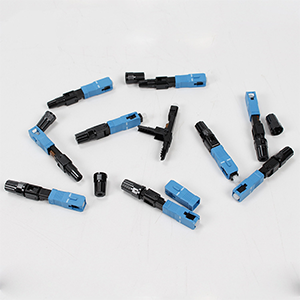Welcome to this blog! I will introduce you to the importance of Wavelength Division Multiplexing (WDM) technology in optical communications, and explain its working principles and application fields in depth. By understanding the basic principles and system working methods of WDM, you will understand how to implement higher bandwidth and larger capacity optical communication systems to meet the growing communication needs.
Wavelength Division Multiplexing (WDM) is a technology widely used in the field of optical communications. As the demand for information communication continues to grow, traditional communication methods can no longer meet the requirements of high bandwidth and high capacity. In this case, WDM technology emerged as the times require, providing a solution for efficient utilization of optical fiber bandwidth for optical communication systems.
WDM technology is based on the principle of wavelength multiplexing, allowing multiple independent optical signals to be transmitted simultaneously, with each signal using a different wavelength for encoding and decoding. This wavelength division multiplexing method enables optical fibers to carry multiple signals at the same time, greatly improving the transmission capacity and bandwidth utilization of optical fibers.
The importance of WDM technology in optical communications is self-evident. It greatly increases the transmission capacity of optical fiber networks and enables high-bandwidth and high-capacity communications. Through WDM technology, optical fiber networks can transmit multiple voice, data and video signals simultaneously to meet the growing communication needs. Moreover, WDM technology can also achieve long-distance transmission, allowing optical signals to span thousands of kilometers without losing signal quality.
In addition to providing high-bandwidth and high-capacity communications, WDM technology is also flexible and scalable. By adjusting optical signals of different wavelengths, optical fiber networks can be flexibly configured and managed according to needs. This flexibility makes WDM technology suitable for various application scenarios, including long-distance transmission, data center interconnection, optical networks and optical sensor networks.
Basic knowledge of optical communications
Optical communication is a communication method that uses optical signals for information transmission. It is based on the transmission characteristics of light and components of optical fiber communication systems, and can provide high-speed, high-bandwidth and low-loss signal transmission.
Light transmission characteristics:
Light is a type of electromagnetic wave with the characteristics of high frequency and high speed. Light waves can propagate in vacuum or in media such as optical fibers. The transmission speed of light is very fast, about 300,000 kilometers per second, which is far faster than the transmission speed of electrical signals. In addition, optical signals have low attenuation and interference characteristics and can be transmitted tens or even hundreds of kilometers in optical fibers without losing signal quality.
Components of optical fiber communication systems:
The optical fiber communication system mainly consists of three components: optical transmitter (light source), optical fiber transmission medium and optical receiver.
-
Light emitter: A light transmitter generates and emits light signals. Common light emitters include laser diodes (LDs) and vertical cavity surface emitting lasers (VCSELs). These light sources can generate high-intensity, stable optical signals and convert digital or analog signals into optical signals through modulation technology.
-
Optical fiber transmission medium: Optical fiber is a flexible optical waveguide composed of optical fibers. It consists of a fiber core and a cladding, and transmits optical signals along the interior of the fiber core through the total reflection characteristics of light. Optical fiber has the characteristics of low loss, high bandwidth and anti-interference, and can be used for long-distance signal transmission.
-
Optical Receiver: An optical receiver receives optical signals and converts them into electrical signals. Photodiodes (PD) or photodetectors (APD) are usually used in optical receivers to receive optical signals and convert them into voltage signals. A receiver also includes a preamplifier, demodulator, and electronic circuitry to amplify and decode the received signal.
Bandwidth limitations and spectrum utilization challenges in traditional communication systems:
In traditional communication systems, electromagnetic waves are used for signal transmission. Due to the limited spectrum resources of electromagnetic waves, there are bandwidth limitations and spectrum utilization challenges. Traditional electrical signal transmission systems have problems with mutual interference in frequency, so spectrum resources need to be divided into different channels for transmission. This frequency division multiplexing method has the problem of low bandwidth utilization and cannot meet the growing demand for high bandwidth.
Optical communication uses WDM technology to overcome the bandwidth limitations and spectrum utilization challenges of traditional communication systems through wavelength multiplexing. WDM technology is capable of transmitting multiple independent optical signals simultaneously, each using a different wavelength for encoding and decoding. In this way, the bandwidth of the optical fiber can be efficiently utilized, which greatly improves the transmission capacity and spectrum utilization of the communication system.
Basic principles of WDM
Wavelength Division Multiplexing (WDM) is a technology based on wavelength multiplexing that achieves high-capacity and high-bandwidth communications by simultaneously transmitting multiple optical signals of different wavelengths in optical fibers.
The basic principle of WDM is to use optical signals of different wavelengths to transmit independently of each other in optical fibers, thereby multiplexing multiple signals. Each optical signal uses a different wavelength to encode and decode, allowing them to coexist in the fiber without interfering with each other. In this way, by transmitting multiple signals simultaneously, the transmission capacity and bandwidth utilization of optical fiber can be greatly improved.
To implement WDM, a device called a wavelength division multiplexer (WDM device) is used. The function of a wavelength division multiplexer is to separate and combine optical signals of different wavelengths.
Specifically, a wavelength division multiplexer usually consists of two main parts: a multiplexer (MUX) and a demultiplexer (DEMUX).
A multiplexer (MUX) is used to combine optical signals from different light sources into a single optical fiber. It receives optical signals from different optical transmitters and transmits them into the same optical fiber while keeping each signal’s wavelength independent.
The splitter (DEMUX) is used to separate multiple wavelength signals combined in one optical fiber. It receives composite signals in optical fibers and separates optical signals of different wavelengths into independent signals for reception and decoding by corresponding optical receivers.
Multiplexers and splitters usually use optical components such as gratings or interferometers to achieve wavelength division multiplexing and separation functions. These devices selectively reflect, refract or interfere according to the wavelength of light, allowing optical signals of different wavelengths to be separated and combined according to predetermined paths.
In short, WDM technology simultaneously transmits multiple optical signals of different wavelengths in optical fibers and uses wavelength division multiplexers to separate and combine signals. This technology enables fiber optic networks to provide high capacity, high bandwidth and flexible communications to meet the growing demand for data transmission.
How the WDM system works
WDM system is a communication system that simultaneously transmits multiple optical signals of different wavelengths in optical fibers. It is mainly composed of optical transmitters, optical receivers, optical fibers and wavelength division multiplexers.
-
Optical transmitter: The optical transmitter is responsible for converting electrical signals into optical signals and sending them into optical fibers. It usually consists of a light source such as a laser diode (LD) or a vertical cavity surface emitting laser (VCSEL). An optical transmitter receives an electrical signal from a signal source and modulates the electrical signal into an optical signal using a modulation technique such as direct modulation or external modulation. Each optical transmitter corresponds to a specific wavelength, and the optical signals generated by different optical transmitters have different wavelengths.
-
Optical receiver: The optical receiver is responsible for receiving the optical signal transmitted in the optical fiber and converting it into an electrical signal. Optical receivers usually use light-sensitive components such as photodiodes (PD) or photodetectors (APD) to receive optical signals. The preamplifier and demodulator in the optical receiver amplify and demodulate the received optical signal into the original electrical signal.
-
Optical fiber: Optical fiber is the medium for optical signal transmission. It consists of core and cladding. Optical signals are transmitted through the core of optical fibers, using the total reflection properties of light to avoid signal loss. Optical fiber has the characteristics of low loss, high bandwidth and anti-interference, and can support long-distance signal transmission.
-
Wavelength division multiplexer: Wavelength division multiplexer is used to separate and combine optical signals. It consists of multiplexer (MUX) and demultiplexer (DEMUX). A multiplexer combines optical signals from different optical transmitters into a single optical fiber, while a splitter separates multiple wavelength signals combined in a single optical fiber. Wavelength division multiplexers achieve wavelength-selective separation and combination through optical components such as gratings or interferometers.
In the WDM system, the modulation and demodulation process of optical signals is a key step. In an optical transmitter, electrical signals are converted into optical signals using modulation techniques. In direct modulation, the electrical signal directly changes the intensity of the light source. In external modulation, the electrical signal passes through a modulator to change the phase or frequency of the optical signal. In this way, the optical signal carries the information of the original electrical signal.
In an optical receiver, the optical signal is received by the receiver and amplified by the preamplifier. The demodulator then demodulates the optical signal into the original electrical signal and recovers the original data.
How to transmit signals of multiple wavelengths to optical fiber at the same time? In a WDM system, the optical signal generated by each optical transmitter has a specific wavelength. These optical signals are combined into an optical fiber through the multiplexer of the wavelength division multiplexer. The optical signals of each wavelength are transmitted independently in the optical fiber without interfering with each other. During the transmission process of optical fiber, the optical signal propagates along the fiber core through the total reflection characteristics of light, maintaining the quality and integrity of the signal. At the receiving end, the splitter of the wavelength division multiplexer separates the composite signal in the optical fiber into optical signals of different wavelengths for the corresponding optical receiver to receive and decode. In this way, signals of multiple wavelengths can be transmitted into the optical fiber simultaneously, achieving high-capacity and high-bandwidth communications.
Application fields of WDM
Wavelength Division Multiplexing (WDM) technology is widely used in the field of optical communications. The following are several common application cases:
-
Long-distance transmission: WDM technology can transmit multiple optical signals of different wavelengths to the optical fiber simultaneously, thus greatly increasing the transmission capacity and bandwidth utilization of the optical fiber. This makes WDM very useful for long-distance transmission, such as in fiber optic backbone networks, where large amounts of data can be transmitted from one city to another over fiber optic links. The high capacity and high bandwidth characteristics of WDM technology make long-distance transmission more efficient and reliable.
-
Data center interconnection: As the scale and demand of data centers continue to grow, the interconnection between data centers has become an important issue. WDM technology can achieve high-capacity and high-speed data transmission by connecting multiple data centers into a fiber optic network. By using WDM technology, large-scale data sharing and real-time data transmission can be achieved between data centers, thereby improving the overall performance and efficiency of the data center.
-
Optical network: WDM technology plays a key role in building optical networks. Optical networks use WDM technology to multiplex optical signals of different wavelengths to achieve high-speed data transmission between multiple nodes. WDM technology can realize parallel transmission of multiple optical channels in optical fiber networks, thereby providing high-capacity, low-latency and high-reliability communications. The applications of optical networks include optical fiber backbone networks, metropolitan area networks, wide area networks, and fiber-to-the-user (FTTX).
WDM technology has many advantages in these application areas, including:
-
Improve bandwidth capacity: WDM technology can transmit multiple optical signals of different wavelengths at the same time, making full use of the bandwidth resources of optical fibers, thus greatly improving the bandwidth capacity of the communication system. This means more data can be transmitted at the same time, meeting the growing demand for data transmission.
-
Increase the signal transmission distance: WDM technology can increase the signal transmission distance in the optical fiber through the total reflection characteristics of light in the optical fiber. Since optical signals are transmitted independently and signals of different wavelengths do not interfere with each other, longer distance transmission can be achieved and signal attenuation and distortion can be reduced.
-
Reduce communication costs: By using WDM technology, the number of optical fibers and infrastructure investment can be reduced. Because WDM technology can transmit multiple signals at the same time, higher transmission capacity can be achieved with the same number of optical fibers, thereby reducing the cost of the communication system.
In general, WDM technology has a wide range of applications in the field of optical communications, including long-distance transmission, data center interconnection and optical networks. Its advantages include improving bandwidth capacity, increasing signal transmission distance and reducing communication costs, providing efficient, reliable and economical solutions for modern communication systems.
Summary:
Thank you for reading this blog. I hope you will have a deeper understanding of the importance and application fields of Wavelength Division Multiplexing (WDM) technology in optical communications. WDM achieves efficient spectrum utilization by simultaneously transmitting multiple optical signals of different wavelengths in optical fibers, solving bandwidth limitations and spectrum resource bottlenecks in traditional communication systems.
If you are looking for reliable high-bandwidth, high-capacity communications solutions, consider using WDM technology. Our products provide advanced WDM technical support and bring huge improvements to your communication network.
WDM FAQ
Lorem ipsum dolor sit amet, consectetur adipiscing elit, sed do eiusmod tempor incididunt ut labore et dolore magna aliqua. Ut enim ad minim veniam, quis nostrud exercitation ullamco laboris nisi ut aliquip ex ea commodo consequat.
Lorem ipsum dolor sit amet, consectetur adipiscing elit, sed do eiusmod tempor incididunt ut labore et dolore magna aliqua. Ut enim ad minim veniam, quis nostrud exercitation ullamco laboris nisi ut aliquip ex ea commodo consequat.

